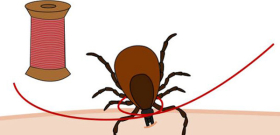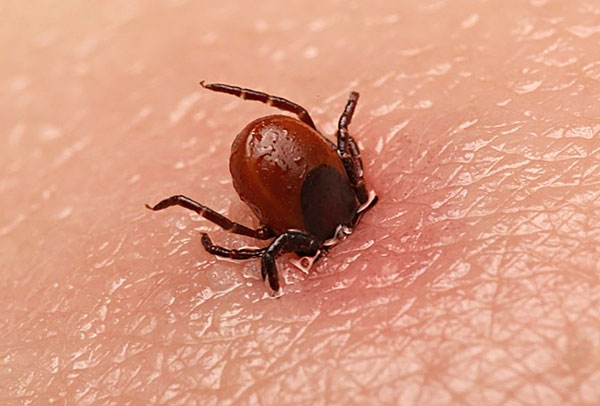
In the warm season, cases of attacks on humans by blood-sucking ixodid ticks become more frequent. There are many scary stories about these arachnids. Let's see what exactly ticks are dangerous for humans.
By itself, the bite of a bloodsucker is not terrible. These parasites are not poisonous, and the amount of blood they can drink is quite negligible and does not bear any negative consequences for the host. However, blood-sucking ticks can be carriers of pathogens of dangerous diseases from one victim of their attack to another.
Many wild animals are a reservoir of various infections, while having resistance to them. With their blood, viruses, bacteria and protozoa can enter the saliva of the parasite, causing a number of diseases in humans. In addition to transmission through the consumed blood, the infection can enter the tick's body sexually: from the male to the female, and from her to the eggs.
In addition to ixodid, argas and gamasid mites are dangerous to humans. Argazids live in hot countries, preferring deserts and steppes, and actively hunt, running in search of prey. They suck blood for about an hour, and their bite causes a strong allergic reaction and itching in humans.
Argas ticks are carriers of relapsing fever and hemorrhagic fever. It only takes one minute for them to transmit the infection.
Among gamasid mites, only a small number of species are parasites: they feed on insects, birds, and small rodents.A person can become their casual victim. Hamazid bites cause severe allergies in humans. These ticks carry vesicular rickettsiosis and typhus.
On a note
There are varieties of mites that harm a person indirectly, for example, barn mites spoil grain and flour, and dust mites cause asthma.
How a tick becomes infected and how it transmits the infection further
The life cycle of a tick consists of four stages: eggs, larvae, nymphs and adults. At each stage, except for the egg, the bloodsucker must find a new host. This type of parasitism is called three-host parasitism.
It is interesting
There are single-host and two-host ixodids, but there are only a few species. In the first case, the larva finds a prey and the arachnid spends the rest of its life on it. In the second, the larva and the nymph live and feed on the same host, while the imago is looking for a new one.
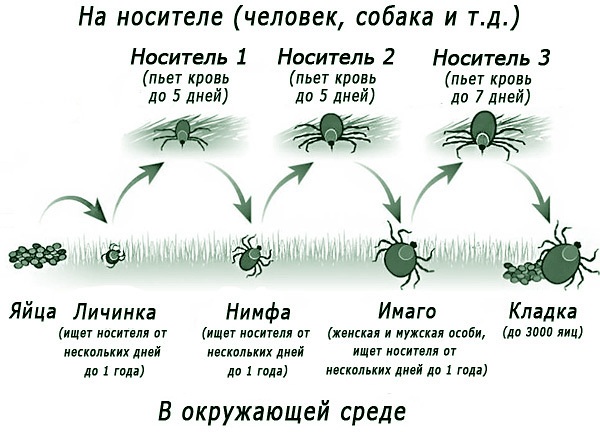
Scheme of the life cycle of a tick.
Since larvae, nymphs and adults feed once, the tick becomes infected at one stage of development, and transmits the infection to the victim at another, after molting and transformation. During this period of time, the causative agent of the disease multiplies in the body of the arachnid. If the larva is infected, then both the nymph and the adult will be carriers of pathogens.
An exception to this rule may be carrier mites of certain species of Babesia. Individuals that have received this pathogen from the mother do not themselves infect the hosts when feeding or transmit them only at the adult stage.
On a note
Infected ticks look no different from their safe counterparts. They all look the same, even ticks of different species can only be distinguished by a specialist. The assertion that encephalitic mites are striped or colored in a different color is simply a myth.
In order to develop successfully, the pathogen must be able to penetrate through the intestines of the tick into the cavity of its body and into the internal organs, resist the protective reactions of the bloodsucker's body and be adapted to the parameters of its internal environment.
For example, the exciter must be resistant to temperature changes. After all, when the bloodsucker eats, his body temperature is almost the same as that of the victim. And after the tick leaves the host, it drops to ambient temperature and in the cold season can reach minus values.
Together with the drunk blood, the infectious agent enters the midgut of the parasite, which is separated from the cavity of its body by the intestinal wall, which has the function of a biological barrier.
The middle intestine is unsuitable for the life of pathogens. Having overcome the intestinal barrier through the intercellular spaces, they find themselves in the hemolymph, which is a comfortable environment for them. But in order to get to the salivary or gonads of the arachnid, the pathogen needs to overcome more than one barrier.
Thus, the fact that a tick fed on the blood of an infected animal does not guarantee that the next host will be infected. The success of the transmission of the pathogen depends on its stability, the rate of replication, the timing of the appearance of infecting stages in the salivary glands and their entry into the saliva itself.
Ixodids infect their victims through a bite - the pathogen enters the body of the prey along with saliva. This route of transmission is called inoculation. Infected saliva enters the thickness of the skin, into the focus of inflammation or directly into the blood.
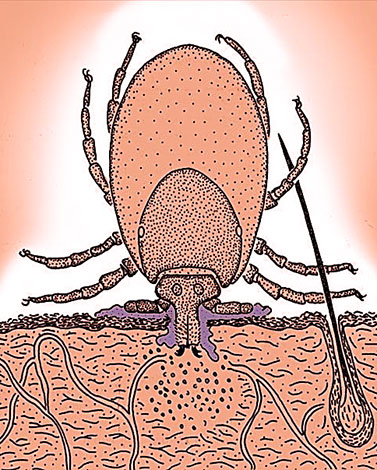
The tick infects the victim through saliva during the bite.
Having migrated to the victim from the tip of grass or a branch of a bush, the tick searches for a place convenient for a bite for a long time, clinging to the host with claws, spikes and hooks covering the limbs of the parasite. He prefers to bite into the body of the victim in a secluded place, from where it will be more difficult to get it and where there is thin skin through which it is easier to get to the blood vessels.
Most often, the arachnid chooses to attach the armpits, ears and the area behind them, the head, inguinal zone, chest, bends of the elbows and knees. In animals, ticks can often also be found on the paws between the toes.
Having found a suitable place, the parasite begins to cut the skin with sharp chelicerae and immerse the proboscis in the resulting hole. The proboscis of the arachnid is covered with rows of curved hooks, and at the end it has sharp teeth that help to go deep into the skin. Such a device of the proboscis allows it, like a harpoon or anchor, to securely gain a foothold in the tissues, which greatly complicates the extraction of the tick.

The proboscis of the tick, like a harpoon, is securely fixed in the body of the victim.
Simultaneously with the immersion of the oral apparatus in the wound, the bloodsucker secretes saliva. In many species of ixodid, it, spreading in the lower layers of the skin, hardens and forms a hard case that provides a strong fixation of the parasite in the skin of the host.
In addition, the saliva of the tick has analgesic properties, so its bite goes unnoticed by the victim. It also contains substances that suppress the host's immune response, preventing it from rejecting the tick.
In the salivary glands of a blood-sucking arachnid, there are over 20 types of secretory cells and 4 types of alveoli.Some begin to secrete saliva at the moment of attachment of the parasite and cease to function by the middle of the process of feeding, others begin to work some time after the start of sucking blood.
Thus, the production of saliva in the tick during bloodsucking is initially minimal, then gradually increases, reaching a maximum in the middle of feeding, and at the end it decreases again. The longer the tick feeds, the more pathogens will be transmitted through its saliva to the victim. That is why it is very important to remove the attached parasite as soon as possible.
The bite of an infected tick does not necessarily lead to illness. For its development, a certain number of pathogens must enter the body of the victim, and this takes time. If you remove the bloodsucker in the first hours after its attachment, the risk of getting sick will be minimal.
On a note
An attack by a female tick is more dangerous than a bite by a male. Adult males need half an hour to satiate, and females can suck the blood of the victim for several days to accumulate enough nutrients to form eggs - so they are more likely to transmit the infection.
Tick-borne infections
Viruses, bacteria and protozoa, which can be contained in the saliva of the parasite, cause diseases that are dangerous for humans. Let's take a closer look at the most famous and common of them.
When it comes to diseases transmitted through a tick bite, tick-borne encephalitis is always mentioned first, although it is less common than, for example, borreliosis. And this is not accidental: encephalitis is a very dangerous disease leading to fatal consequences for the body.
The virus that causes this disease affects the human nervous system and brain. Tick-borne encephalitis threatens with serious complications, disability and even death. There is no cure for this disease, and the only way to reliably protect yourself from it is through vaccination. Those infected with tick-borne encephalitis require hospitalization and supportive care to reduce the severe consequences of the infection.
The disease begins with a high fever, muscle pain, headache, nausea. Then within eight days there is a remission, and after it - the second phase of fever, severe headache, meningitis and impaired consciousness.

Symptoms of tick-borne encephalitis.
The main carrier of encephalitis is the taiga tick (Ixodes persulcatus) - thus, it turns out to be the most dangerous tick in the world. This parasite prefers coniferous forests, but is also found in mixed, broad-leaved, and even forest-steppe forests. More than 130 species of warm-blooded animals and birds serve as natural reservoirs for the tick-borne encephalitis virus.
Tick-borne encephalitis is not common throughout Russia. The lists of endemic regions can be found on the Rospotrebnadzor website. This service annually collects statistics on tick bites and encephalitis infections in the Russian Federation. The most dangerous for this indicator are Buryatia, Udmurtia, Altai, Kurgan, Sverdlovsk, Tomsk and Tyumen regions, Kostroma and Perm regions.
And, for example, leaving for Sochi, you can not be afraid of contracting encephalitis, but this does not negate the possibility of picking up other dangerous infections through a parasite bite.
The most common disease carried by blood-sucking arachnids is tick-borne borreliosis, or Lyme disease.Among all incidents of human infection with tick-borne infections, 90% of cases occur precisely in borreliosis. Most often, it is carried by a dog, or European forest, tick (Ixodes ricinus). The causative agents of the disease are several types of bacteria of the genus Borrelia.
Lyme disease affects the musculoskeletal system, nervous system and internal organs of a person. The main symptom of this disease is erythema migrans annulus. It is an irregularly shaped reddening around the site of attachment of the parasite that expands over time.

Redness in the form of a ring around the site of a tick bite is the main symptom of tick-borne borreliosis.
The disease develops over several months and seriously affects the body. At the initial stage, it is easily treated with antibiotics, but in an advanced case it becomes chronic, leading to arthritis and osteoporosis, bone destruction, and sometimes death of the victim.
In addition to tick-borne encephalitis and borreliosis, with a tick bite, you can become infected with tularemia, ehrlichiosis, hemorrhagic fever, babesiosis, typhus and some other transmissible diseases.
Tularemia is caused by the bacterium Francisella tularensis, named after the locality of Tulare in California where it was first discovered. The carriers of this pathogen are rodents and lagomorphs. In addition to the bite of a tick, infection can occur through contaminated water, food and contact with a rodent, less often by airborne droplets.
In humans, this disease causes severe headache, fever, diarrhea, sleep disturbances, night sweats, and inflammation of the lymph nodes. The patient needs hospitalization and antibiotic treatment.
Ehrlichiosis, caused by bacteria of the genus Ehrlichia, affects the skin, nervous system, bone marrow, liver, and cardiovascular system. It manifests itself in the form of severe fever, headache and muscle pain, nausea, dizziness.
The causative agent of Crimean-Congo hemorrhagic fever is a virus from the Bunyaviridae family. It affects the circulatory system and causes hemorrhages in the internal organs and on the skin.
Babesiosis, or piroplasmosis, usually affects animals from the bite of a parasite, but sometimes humans can also suffer. This disease is caused by a protozoan - Babesia. At risk are the elderly, HIV-infected people, people who have recently undergone serious illness or surgery.
Symptoms of the disease are high fever and enlargement of the spleen and liver. In people with a normal immune system, babesiosis goes unnoticed.
Tick-borne typhus is caused by rickettsiae. It manifests itself in the form of acute fever, rash, headache and muscle pain. Treated with antibiotics.

After a tick bite, you can become infected with tick-borne typhus, a sign of which are rashes on the body.
Tick-borne relapsing fever is carried by argazids. Its causative agents are spirochetes. This disease is manifested by recurrent febrile attacks and symptoms of general intoxication. There may be complications in the form of pneumonia and heart damage.
Is it possible to get infected from a bloodsucker without a direct bite
Infection with tick-borne infections can occur not only with a bite. The decisive factor is the entry of infected saliva and parasite entrails into the tissues or bloodstream, either directly or by ingestion, for example, if a live arachnid is accidentally swallowed.
You can become infected if you crush a tick that is on the skin, and its contents fall into an accidental wound or scratch. Therefore, you should not press the parasite that has stuck to a dog or cat with your bare hands - there may be invisible skin lesions on your fingers that will become a gateway for infection.
There is also a risk of contracting tick-borne encephalitis through raw goat or cow milk. This is possible if they were bitten by an infected parasite or accidentally swallowed it along with the grass. Therefore, it is always necessary to boil fresh milk.

You can get tick-borne encephalitis through raw milk.
There is a risk of bringing a tick into the house on clothes or on an animal, so after a walk you need to shake out clothes and inspect your pet. Although, with the help of hooks on the paws, the parasite clings tightly to the chosen victim and will not voluntarily leave it, and the air in city apartments is dry and uncomfortable for the life of the tick, there is still a chance, albeit a small one, that the bloodsucker that has entered the house will still get up to a person.
But if the tick got drunk on blood and fell off, then you should not be afraid of it. At each life stage, these arachnids feed only once. After that, the larva and nymph should molt, and the adult female will look for a place to lay eggs, but the conditions of a human dwelling are not suitable for the further development of the arachnid.
If the tick did not have time to stick, but simply crawled through the body, you can not be afraid of infection, since there was no contact of the parasite's saliva with the host's blood. It is also worth knowing that the bloodsucker is not able to bite through clothes and even thin tights.
A dog or cat bitten by a tick is not dangerous to humans, but they should be taken to the veterinarian.
What time of year can you get infected
In the temperate and subtropical climate in Russia, ticks are not able to maintain constant activity throughout the year. They have to go into hibernation-diapause during periods of cold winter and dry summer months. At this time, they cease to be dangerous.
In different regions, depending on the climate, ticks hibernate at different times.
Parasites appear in the spring after the snow melts and remain active until the onset of cold weather. This usually happens from April to October. Bloodsuckers come out of hibernation hungry and direct all their forces to search for prey - at this time they are the most dangerous. At the end of April - beginning of May there is a particularly large number of tick attacks.

Schedule of seasonal activity of ticks.
During the summer heat, these arachnids are less active and have to hide in damp places in order to survive, so the number of tick bites decreases sharply at this time. They are waiting for the end of summer. And from mid-August to September, there is a second peak in the activity of bloodsuckers.
The cyclicity of tick attacks, in addition to the connection with the seasons, depends on the characteristics of their life cycle. After feeding, the parasite must molt or form and lay eggs, which also need time to mature.
The larvae are not dangerous for humans: they are very small in size and it is difficult for them to bite through human skin. They usually crawl into burrows and suck the blood of rodents. Nymphs and adults prefer larger warm-blooded animals and may attack humans.
How to protect yourself from a tick bite
To avoid the bite of a bloodsucker during a forest walk, you need to follow simple rules:
- Wear closed clothing in light colors with a tight collar and cuffs, use a hat - this will make it more difficult for the parasite to get to the body. And on a light background it is easier to notice the arachnid;
- Inspect clothes every 15-20 minutes for ticks, and check the whole body at a halt;
- Avoid animal trails and pastures - the smell of animals attracts bloodsuckers. Do not go out into clearings with tall grass and bushes, or at least try not to touch blades of grass and branches, as parasites prefer to wait for their victims on them. Ticks do not jump - direct contact with prey is important to them;
- Use anti-tick agents for people and animals.
Reliable protection against tick-borne encephalitis virus is timely vaccination. It should be done when planning a trip to a region endemic for this disease, with permanent residence in it, and also if your occupation is related to work in the field. It is important to vaccinate in advance. The first dose of the vaccine is administered in the fall, the second - after 1-3 months. In this case, by the beginning of the tick season, you will have time to form immunity. The first revaccination is carried out in a year, then it must be repeated every three years.
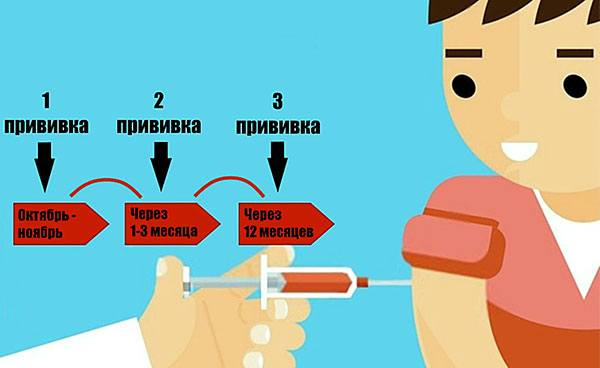
Vaccination schedule for tick-borne encephalitis.
What to do if the parasite still stuck
If you find a stuck tick, the first thing to do is to remove it as soon as possible. To do this, use a special pliers or improvised means, for example, a thread. You can pull out the bloodsucker with your hands.
When extracting the parasite, the main thing is to twist it (no matter in which direction), and not to pull it out. Usually a couple of turns is enough for this.
In a region endemic for tick-borne encephalitis, the extracted arachnid must be submitted for analysis. It is advisable to keep him alive. To do this, place the tick in a tightly closed container along with a piece of damp cotton wool.
The addresses of laboratories where such tests are performed can be found by calling an ambulance or by contacting a hospital or emergency room. This procedure takes 2-3 days and costs from 500 to 1000 rubles. First of all, the parasite is checked for carriage of the tick-borne encephalitis virus, but it is possible to conduct a study to identify pathogens of other diseases.
In hospitals in endemic regions, human immunoglobulin serum against tick-borne encephalitis is administered as a prophylaxis even before the results of the analysis are received. It reduces the chance of getting sick. If a pregnant woman is bitten, the decision to administer this drug is made by the infectious disease specialist.
The virus can be transmitted through breast milk to the baby, so lactating women should stop breastfeeding until the test results are available.
After the bite, you need to monitor the well-being of the victim for a month. If you experience headache and muscle pain, swelling and pain at the bite site, fever, nausea, convulsions, impaired consciousness and coordination, you should immediately seek medical help.
It is because of the transmitted infections that ticks are very dangerous for humans, so do not neglect the above protection methods and treat the bites of these small arachnids lightly. You need to remember the rules of behavior in nature, including explaining them to children when going out of town.
Useful video: how to protect yourself from tick attacks

